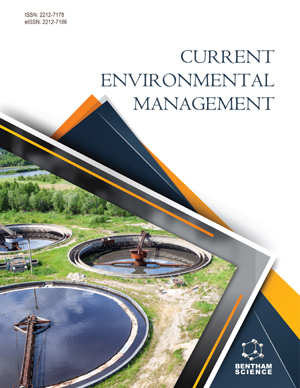Abstract
Removal of heavy metals is very important in wastewater treatment process, due to their abundant hazardous effects. There are various chemical and physical methods including ion exchange, reverse osmosis, electrodialysis, and ultrafiltration for removing heavy metals from wastewater, but biological treatment has attracted researchers for years as it is cheap and efficient. Microalgae have a significant capability of absorbing and eliminating heavy metals from wastewater. One of the most attractive microalgae species for this application is the Chlorella vulgaris Beijerinck. The current study takes a literature review of using microalgae species, especially C. vulgaris, with the aim of wastewater heavy metal treatment. In this regard firstly, various methods of eliminating heavy metals using microalgae were investigated, and then the application of C. vulgaris in the process of eliminating heavy metals from wastewater is fully presented. It became obvious that the use of C. vulgaris application is more helpful in the case of Copper, Lead, Zinc, Cadmium, and Nickel. Moreover, the main factor affecting heavy metal treatment using C. vulgaris is the pH of media, and the second effective parameter is temperature that is often considered about 25°C. The appropriate time period for the treatment was 5-7 days. Generally, C. vulgaris presented a very favorable efficiency in eliminating various heavy metals and is capable of removing heavy metals from wastewater to more than 90% on average.
Keywords: Adsorption, Chlorella vulgaris, heavy metals, microalgae, pollution, ultrafiltration.
Graphical Abstract
[http://dx.doi.org/10.1016/S0048-9697(02)00197-3] [PMID: 12449334]
[http://dx.doi.org/10.1007/978-1-60327-031-1]
[http://dx.doi.org/10.1016/j.biotechadv.2008.11.002] [PMID: 19103274]
[http://dx.doi.org/10.1042/BA20100196] [PMID: 20923412]
[http://dx.doi.org/10.1007/s001289900853] [PMID: 9933311]
[http://dx.doi.org/10.1016/S0921-3449(99)00010-5]
[http://dx.doi.org/10.1016/j.ecoenv.2014.12.019] [PMID: 25528489]
[http://dx.doi.org/10.1016/j.biotechadv.2006.03.001] [PMID: 16737792]
[http://dx.doi.org/10.1016/0167-7799(87)90027-8]
[http://dx.doi.org/10.1021/es00144a018] [PMID: 22288814]
[http://dx.doi.org/10.1016/j.biortech.2010.06.035] [PMID: 20594826]
[http://dx.doi.org/10.1016/j.jhazmat.2006.07.026] [PMID: 16956722]
[http://dx.doi.org/10.1016/j.sjbs.2012.04.005] [PMID: 24936135]
[http://dx.doi.org/10.2306/scienceasia1513-874.2002.28.253]
[http://dx.doi.org/10.1023/A:1007911119029]
[http://dx.doi.org/10.1016/j.plaphy.2011.11.009] [PMID: 22305067]
[http://dx.doi.org/10.1016/j.ecoleng.2011.10.007]
[http://dx.doi.org/10.1016/S0304-386X(03)00138-5]
[http://dx.doi.org/10.1093/oxfordjournals.pcp.a075237]
[http://dx.doi.org/10.1016/j.chemosphere.2004.08.057] [PMID: 15504484]
[http://dx.doi.org/10.1016/0043-1354(87)90028-5]
[http://dx.doi.org/10.1016/j.jhazmat.2007.11.064] [PMID: 18178002]
[http://dx.doi.org/10.1016/j.biortech.2011.11.124] [PMID: 22178497]
[http://dx.doi.org/10.1007/s11274-009-0292-z] [PMID: 24026927]
[http://dx.doi.org/10.1016/j.rser.2009.04.005]
[http://dx.doi.org/10.1007/s10499-011-9440-1]
[http://dx.doi.org/10.1016/j.seppur.2015.04.011]
[http://dx.doi.org/10.1016/j.egypro.2014.12.064]
[http://dx.doi.org/10.1016/S0960-8524(97)00029-1]
[http://dx.doi.org/10.1021/sc400289z]
[http://dx.doi.org/10.1007/BF01195827] [PMID: 24425389]
[http://dx.doi.org/10.1080/07388550500248571] [PMID: 16294830]
[http://dx.doi.org/10.1023/A:1010785000977] [PMID: 11433549]
[http://dx.doi.org/10.1016/j.chemosphere.2005.11.024] [PMID: 16405948]
[http://dx.doi.org/10.1016/j.sajce.2017.06.005]
[http://dx.doi.org/10.1016/S0925-8574(00)00174-9]
[http://dx.doi.org/10.1016/j.wasman.2005.09.017] [PMID: 16298121]
[http://dx.doi.org/10.1016/j.procbio.2005.07.018]
[http://dx.doi.org/10.1016/S1001-0742(08)60036-4] [PMID: 18574966]
[http://dx.doi.org/10.1016/j.procbio.2005.10.025]
[http://dx.doi.org/10.1016/j.cej.2011.07.039]
[http://dx.doi.org/10.1016/j.jhazmat.2008.07.046] [PMID: 18755544]
[http://dx.doi.org/10.1007/s12010-010-9005-1] [PMID: 20567935]
[http://dx.doi.org/10.1002/jctb.4179]
[http://dx.doi.org/10.1016/j.biortech.2014.10.124] [PMID: 25459865]
[http://dx.doi.org/10.1016/S1369-703X(99)00053-4]
[http://dx.doi.org/10.1016/0048-9697(91)90344-E]
[http://dx.doi.org/10.1016/j.jhazmat.2012.03.022] [PMID: 22480702]
 18
18 2
2


